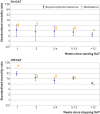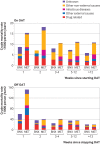Opioid agonist treatment and risk of mortality during opioid overdose public health emergency: population based retrospective cohort study
- PMID: 32234712
- PMCID: PMC7190018
- DOI: 10.1136/bmj.m772
Opioid agonist treatment and risk of mortality during opioid overdose public health emergency: population based retrospective cohort study
Abstract
Objective: To compare the risk of mortality among people with opioid use disorder on and off opioid agonist treatment (OAT) in a setting with a high prevalence of illicitly manufactured fentanyl and other potent synthetic opioids in the illicit drug supply.
Design: Population based retrospective cohort study.
Setting: Individual level linkage of five health administrative datasets capturing drug dispensations, hospital admissions, physician billing records, ambulatory care reports, and deaths in British Columbia, Canada.
Participants: 55 347 people with opioid use disorder who received OAT between 1 January 1996 and 30 September 2018.
Main outcome measures: All cause and cause specific crude mortality rates (per 1000 person years) to determine absolute risk of mortality and all cause age and sex standardised mortality ratios to determine relative risk of mortality compared with the general population. Mortality risk was calculated according to treatment status (on OAT, off OAT), time since starting and stopping treatment (1, 2, 3-4, 5-12, >12 weeks), and medication type (methadone, buprenorphine/naloxone). Adjusted risk ratios compared the relative risk of mortality on and off OAT over time as fentanyl became more prevalent in the illicit drug supply.
Results: 7030 (12.7%) of 55 347 OAT recipients died during follow-up. The all cause standardised mortality ratio was substantially lower on OAT (4.6, 95% confidence interval 4.4 to 4.8) than off OAT (9.7, 9.5 to 10.0). In a period of increasing prevalence of fentanyl, the relative risk of mortality off OAT was 2.1 (95% confidence interval 1.8 to 2.4) times higher than on OAT before the introduction of fentanyl, increasing to 3.4 (2.8 to 4.3) at the end of the study period (65% increase in relative risk).
Conclusions: Retention on OAT is associated with substantial reductions in the risk of mortality for people with opioid use disorder. The protective effect of OAT on mortality increased as fentanyl and other synthetic opioids became common in the illicit drug supply, whereas the risk of mortality remained high off OAT. As fentanyl becomes more widespread globally, these findings highlight the importance of interventions that improve retention on opioid agonist treatment and prevent recipients from stopping treatment.
© Author(s) (or their employer(s)) 2019. Re-use permitted under CC BY-NC. No commercial re-use. See rights and permissions. Published by BMJ.
Conflict of interest statement
Competing interests: All authors have completed the ICMJE uniform disclosure form at www.icmje.org/coi_disclosure.pdf and declare: funding support from Health Canada SUAP; no financial relationships with any organisations that might have had an interest in the submitted work in the previous three years; no relationships or activities that could appear to have influenced the submitted work.
Figures



References
-
- Degenhardt L, Charlson F, Ferrari A, et al. GBD 2016 Alcohol and Drug Use Collaborators The global burden of disease attributable to alcohol and drug use in 195 countries and territories, 1990-2016: a systematic analysis for the Global Burden of Disease Study 2016. Lancet Psychiatry 2018;5:987-1012. 10.1016/S2215-0366(18)30337-7 - DOI - PMC - PubMed
-
- British Columbia Coroners Service. Fentanyl-detected illicit drug overdose deaths: January 1, 2012 to January 31, 2019. 2019. https://www2.gov.bc.ca/assets/gov/birth-adoption-death-marriage-and-divo....
Publication types
MeSH terms
Substances
LinkOut - more resources
Full Text Sources
Medical
Research Materials
